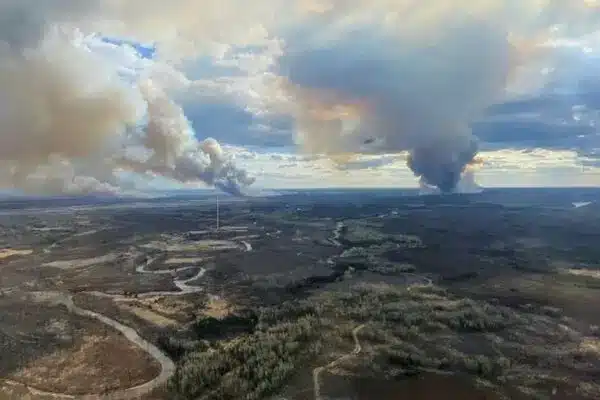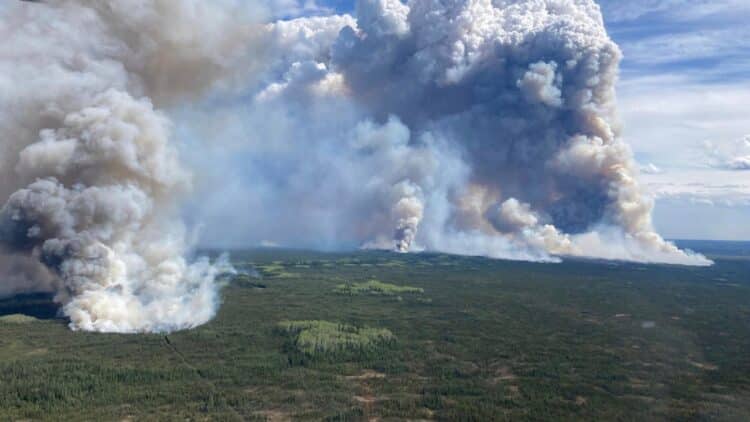Hundreds of residents in four neighborhoods in the southern end of Canada’s oil sand hub of Fort McMurray, Alberta, were ordered to evacuate with a wildfire threatening the community, authorities said Tuesday.
The Rural Municipality of Wood Buffalo said residents in Beacon Hill, Abasand, Prairie Creek and Grayling Terrace needed to leave by 4 p.m.
An emergency evacuation warning remained in place for the rest of Fort McMurray and surrounding areas.
The rural municipality said the residents in the four neighborhoods were being ordered out to clear room for crews to fight the fire, which had moved to within 13 kilometers (8 miles) of the city.
Also Read – Greek Authorities Arrest 79 ‘Arsonist Scum’ In Connection With Devastating Wildfires
Fort McMurray has a population of about 68,000, and a wildfire there in 2016 destroyed 2,400 homes and forced more than 80,000 people to flee.
“It’s very important for me to know that this fire activity is very different than the 2016 Horse River wildfire. We have an abundance of resources and we are well positioned to respond to this situation,” Regional Fire Chief Jody Butz said.

This photo provided by the BC Wildfire Service shows a view of the Parker Lake wildfire near Fort Nelson, B.C. on Monday, May 13, 2024. (BC Wildfire Service/The Canadian Press via AP)
Suzy Gerendi, who runs the dessert shop in the Beacon Hill neighborhood, said she was already packed up when the evacuation order came down. Gerendi lived in Beacon Hill when fire overtook it in 2016.
She immediately began the drive towards Edmonton, Alberta with her three dogs.
“It’s very, very dark and orange,” Gerendi said. “It brings up some memories and it’s not a good feeling.”
Residents were also dealing with heavy smoke and ash.
“It’s dark. The smoke is everywhere,” said resident Else Hoko.
Hoko picked up her two sons from school in Abasand after receiving the evacuation order. She had also fled in 2016.
“I’m so stressed,” she said, adding that she’s praying for rain.
The Beacon Hill and Abasand neighborhoods saw serious losses in 2016.
The current fire has grown to about 110 square kilometers (42.5 square miles) and remains out of control.

Josee St. Onge, an Alberta Wildfire information officer, said wind is pushing the fire toward the community.
She said crews have been pulled from the fire line for safety reasons, and air tankers and helicopters continue to drop water and retardant on the “active edges.”
“Unfortunately, these are not favorable winds for us, and the fire will continue to advance towards the town until we see a wind shift,” she said.
In the northeast of the neighboring province of British Columbia, areas subject to mandatory evacuation increased, with the latest order Monday for Doig River First Nation and the Peace River Regional District as a fire threatened nearby.
Forecasts on Tuesday called for wind that could blow a growing wildfire closer to Fort Nelson. Emergency workers had been phoning as many of the estimated 50 residents still in town and urging them to go.
The British Columbia Wildfire Service said the blaze had grown to 84 square kilometers (32 miles). On Monday, it was about 53 square kilometers (21 miles) in size. A photo by the service shows the billowing blaze spreading in a vast wooded area.
The community of about 4,700 and the neighboring Fort Nelson First Nation have been under an evacuation order since Friday.
Northern Rockies Regional Municipality Mayor Rob Fraser said one drawback of the evacuation is the challenge for essential staff, including firefighters, to find food.
“This is really going to be weather dependent, and so far the weather has been holding with us,” Fraser said of the wildfire in a video posted to Facebook.
CLICK HERE TO GET THE FOX NEWS APP
In 2023, Canada experienced a record number of wildfires that caused choking smoke in parts of the U.S. and forced more than 235,000 Canadians to evacuate their communities. At least four firefighters died.
Several wildfires are burning across western Canada.
(this story has not been edited by TSA Mag staff and is published from a syndicated feed.)
















